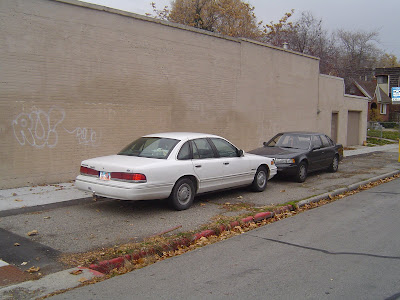
A meeting was held last Thursday to discuss the Council Draft version of the Joaquin Neighborhood's parking permit program. The meeting was held primarily for South Joaquin residents, who listened, provided feedback, and voted. The vote was 20 - 13 in favor of the permit program. Concerns were focused on visitor parking, and the implementation of the plan.
There were some points that I feel need further explanation. First of all, the basics of the permits. A permit entitles you to park in a particular subdistrict, and owner occupants can get 2 free, and purchase one other. The permits will be "hanging" meaning they can be transferred from car to car as needed. So, if you have a driveway that holds 2 cars, and you have 3 "cars" of visitors, you can use those permits for your visitors, and still be able to handle everyone. Permits for owner occupants are not car specific. They will be for tenants.
Another issue--businesses must be located without the technical boundaries of the neighborhood in order to be eligible for permits. So, Central Business District businesses won't be eligible. That includes all University Ave located businesses.
Things that I feel we need to change, or improve:
There were some points that I feel need further explanation. First of all, the basics of the permits. A permit entitles you to park in a particular subdistrict, and owner occupants can get 2 free, and purchase one other. The permits will be "hanging" meaning they can be transferred from car to car as needed. So, if you have a driveway that holds 2 cars, and you have 3 "cars" of visitors, you can use those permits for your visitors, and still be able to handle everyone. Permits for owner occupants are not car specific. They will be for tenants.
Another issue--businesses must be located without the technical boundaries of the neighborhood in order to be eligible for permits. So, Central Business District businesses won't be eligible. That includes all University Ave located businesses.
Things that I feel we need to change, or improve:
- I feel the amount of free visitor "one day" spots available to each address needs to be increased. These will be a print-off the web sort of permit. The current plan gives 6 a year per address. That just isn't enough.
- I will probably recommend that instead of having 3 subdistricts within South Joaquin, there would be just 1 overall district. This would make it easier for folks to visit friends, home /visit teach, etc.
- I plan to recommend an "appeal" process which could enable residents with special circumstances to request additional permits, or perhaps more "visitor permits."
- I plan to request a program which would allow local church buildings to request non-enforcement periods on streets immediately surrounding their buildings.
I am still hoping for input from each of you.
